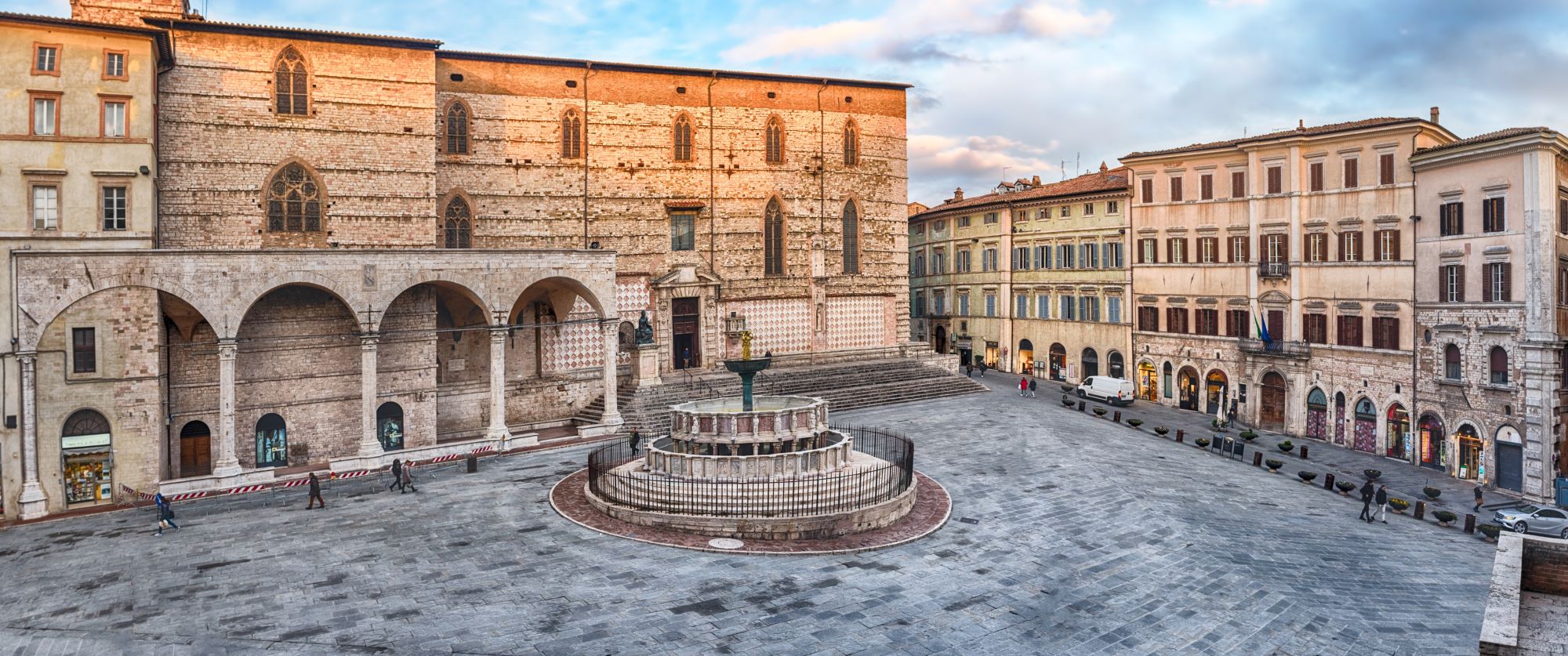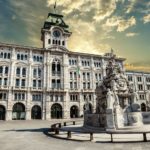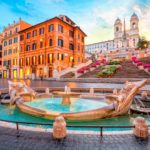The best of Perugia
The city known throughout Italy for its chocolate festival, the famous Euro-chocolate that every year brings gourmets into the city, is the ideal get-away town, not just for Italians. Perugia is home of the great art and two major universities. This little town has an air of modern and thousands of years of history. Let’s begin…
Where is Perugia
Perugia is the capital of the Italian region of Umbria, one of the greenest regions in Italy. Surrounded by green hills and snowy mountains – in the winter season – Perugia lies in Central Italy. It is often called the “green heart of Italy” or “Il cuore verde d’Italia.”
Quite close to many other breathtaking places, it takes just about half an hour to get from Perugia to Assisi. Make sure to visit both of them!
Perugia is reachable by train, quite easily from the major Italian cities: Milan, Florence and Rome.
Explore Peruigia
Start your visit from the heart of the city, the square called The Piazza IV Novembre. Structured and decorated by some exceptional illustrations of medieval and early Renaissance architecture and sculpture, Piazza IV Novembre has Fontana Maggiore at its center, a medieval monumental fountain built in the 13th century. The fountain was designed to receive water from the local aqueduct and is also an important work of art. Piazza IV Novembre (4th November) is considered to be one of Italy’s prettiest squares. Take a moment to admire the Fontana Maggiore and its incredible details. If you are a square lover, you will love this article about the best square of Rome.
Surrounding Piazza IV Novembre
The northern side of the square is occupied by the splendid Cathedral of San Lorenzo which faces the main square with its flank side, and is adorned with beautiful qua-trefoil relief in pink marble. This beautiful cathedral comprises of multitude styles and different eras. All of this perfect imperfection gives the church a very unique and ragged beauty.
On the south-eastern corner is located Palazzo dei Priori. It is a 13th century palace located along the Corso Vannucci street. This fortress-like structure cannot be missed when you are strolling along the Perugian street. This incredible master piece is a fortress with its crenelated walls, Gothic windows and two majestic sculptures presiding over the entrance- one of the griffin, a symbol of the city, and the other of the lion, a symbol of the Guelph fraction during political turmoil in the Middle Ages. Today Palazzo Dei Priori is home to Galleria Nazionale dell’Umbria, which has the largest collection of spectacular works of art in the central Italy!
These buildings are very old but well kept. Visit the Cathedral and the Palace with your private local tour guide, as who knows the secrets of the city better than the locals?
Strolling through the main streets
Discover Corso Vanucci which is the main street of Perugia and it attractions. It beams with life, beautiful music and much more. Aromatic smells surround you as you walk past the restaurants inviting you in with every step you take. Beautiful piazzas open their arms to you with soothing comfort. Strolling through the street will bring you to the next “Peruginian” attraction which will be a nothing short of satisfaction.
Just a few steps away from the northern side of Piazza IV Novembre, there is Pozzo Etrusco. Do you know who the Etruscan were? The ancient civilization that colonized a good part of central Italy more than 2700 years ago. They founded Perugia, and today you can still find some things from that age, like this well. We strongly recommend a visit. From the Etruscan well, continue your walking tour to Rocca Paolina. It’s an old fortress, built between 1540 and 1543 by the Pope Paolo III, in order to represent and maintain the power of the city of Perugia, until 1860. It’s one of the symbols of the city still today. Visiting this old fortress is like going back to the 17th century.
Get lost in the historical center
As always, one of the best things to do in an unknown city, is to get lost in its center. Perugia is quite small, so you’ll never be really lost, but it’s interesting to see the narrow medieval streets and to enter a couple of churches.
Continue your tour towards Giardini Carducci.
These small gardens are just below Rocca Paolina. It’s more like a panoramic terrace, not really a garden, but the view is impressive. During a clear, sunny day, you’ll be able to see the beautiful valley below and the mountains in the background. It’s a truly romantic place. About 1km north-east from Giardini Carducci, you’ll find Porta Sole. There, you’ll find the most beautiful landscape of Perugia. Continue down onto the old stairwell, and go toward Via dell’acquedotto. The most famous street of the city. Acquedotto means “aqueduct”. Built between 1254 and 1280, the purpose of the aqueduct was to bring water from Monte Pacciano to the Fontana Maggiore, (remember the story from beginning?).
Oratorio di San Bernardino is one of the most important buildings in Perugia! This beautiful 15th century creation’s main feature is the extraordinary design by Agostino di Duccio.
Oratorio di San Bernardino facade is considered to be the most important Renaissance monument in Perugia and its beauty is second to none! The arrangement of red and white marble, together with limestone and terracotta, create a great support to the decorative story of San Bernardino’s miracles.
Eurochocolate festival
Did your eyes just jump over the letters and only see “chocolate?” Each year since 1993, Perugia transforms into a dessert lover’s paradise. The Eurochocolate festival is a ten-day event in which you have the opportunity to mix with fellow chocolate lovers as well as all of the best producers around the world.
The festival is usually on October, with each day bringing new delights and activities for guests. Perfect for those of us that would rather just eat the chocolate than make it.
The city of Perugia has been associated with chocolate since the Perugina candy company (makers of the famed Bacio hazelnut and chocolate candy) was founded there in 1907. Eurochocolate focuses on a theme each year, and the city streets are lined with outdoor stands where chocolate and candy companies from across the world sell their wares, and chocolate and cooking workshops are held across the city.
One of the chocolate brands you’ll see at the Festival is the Perugina Baci. You can take a tour of the factory where these little chocolate treats are made, which includes the factory and the museum.
Bring your wallet and sweet tooth because you’ll definitely be needing both.
Taste of Perugia
The Umbrian cuisine has a good number of quality cold cuts, as well as excellent homemade pasta, tasty sauces and traditional desserts.
From sweet and creamy to cave-aged and sharp, Umbria serves up a variety of Pecorino (sheeps milk) and Caciottio (cow’s milk) cheeses to pair with a glass of local wine, dry wine or at the end of your meal before dessert. Umbria has a great selection of cheeses which are worth a taste.
Without any doubts, one of the most valuable products of the territory of Perugia is the truffle. Truffle, usually mixed with homemade pasta (tart but very tasty,) and some local cheese is a pure paradise for your palate.
One of the most traditional dishes is Torta al testo or “Cake of the Tile” but a better translation could be “Bread of the Tile” not to be missed. The “torta al testo” is a very old traditional food of Perugia. It is a flat bread made from flour, water, olive oil, a pinch of salt.
A lightly leavened bread made on a huge flat round stone in a fire, this bread is classically Umbrian, and specifically from Perugia.
Somewhat like a pita, the torta can be stuffed with any number of grilled meats and veggies.
Curiosity
On the outskirt of Perugia Italy, lies the Perugina School of Chocolate. A unique location where chocolate lovers can experience the unforgettable taste of Italy. A school to discover the secrets of chocolate-making, learn the techniques to create impressive masterpieces. Come to Italy and discover the art of chocolate making at Perugina School of Chocolate.
I hope that you enjoyed this insight into Perugia and that you get inspired to learn more or see for yourself! If you enjoyed this blog post, share it with a friend and if you are interested in learning more about traveling to this area or any other region in Italy, please contact us for more information.
Stay tuned for more blogs about other regions in Italy and be sure to click the link below for an example of tours we offer in Perugia area.





